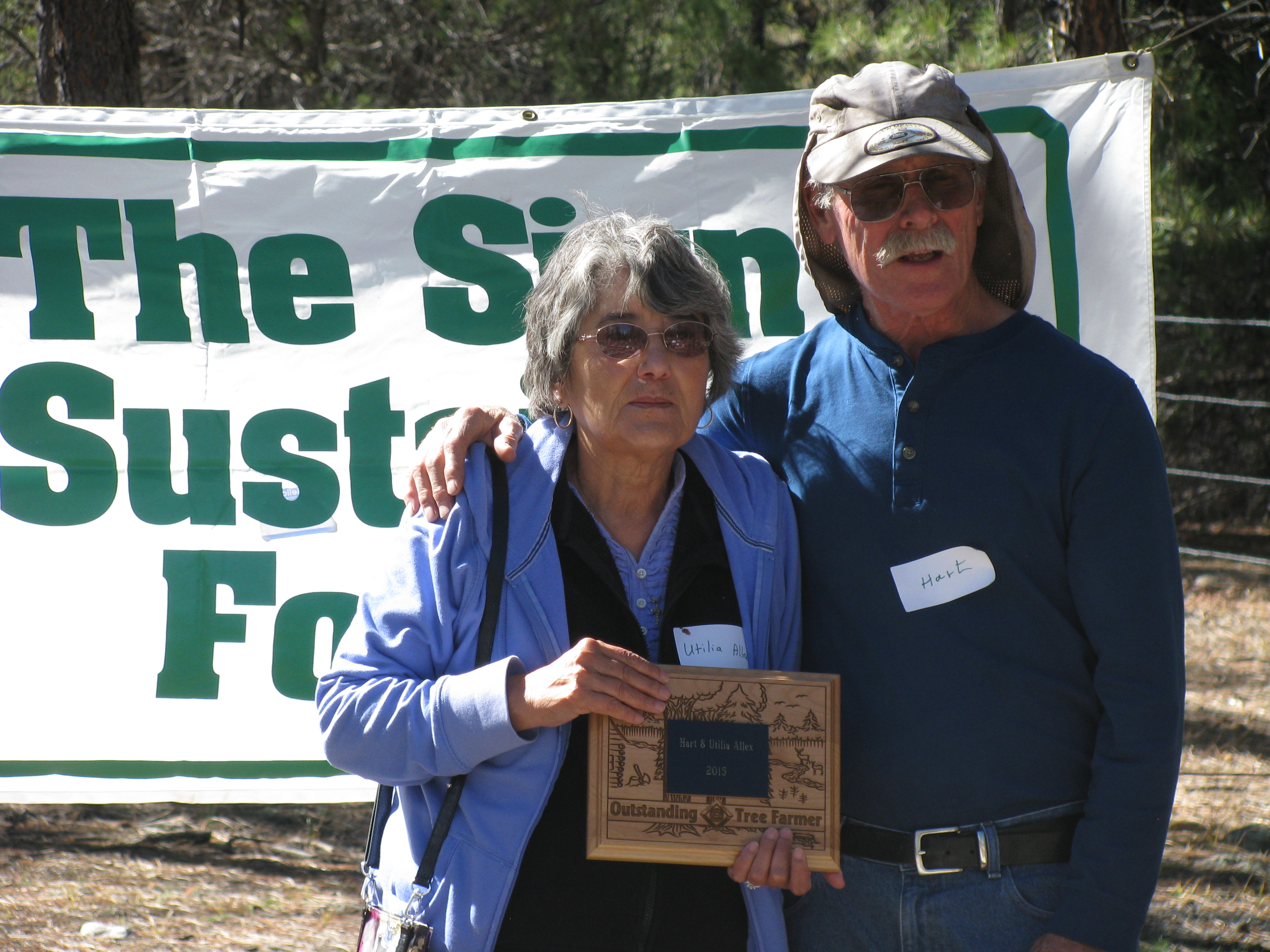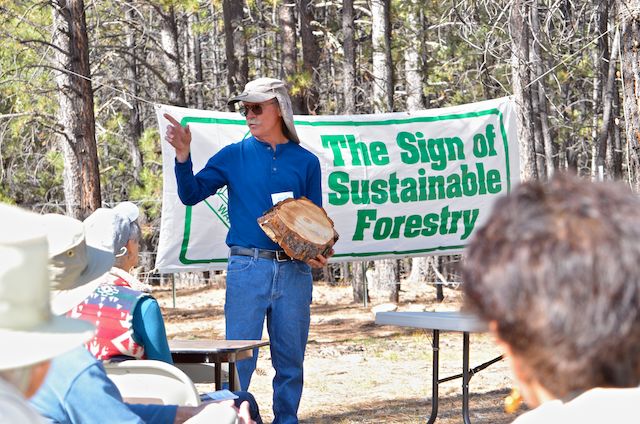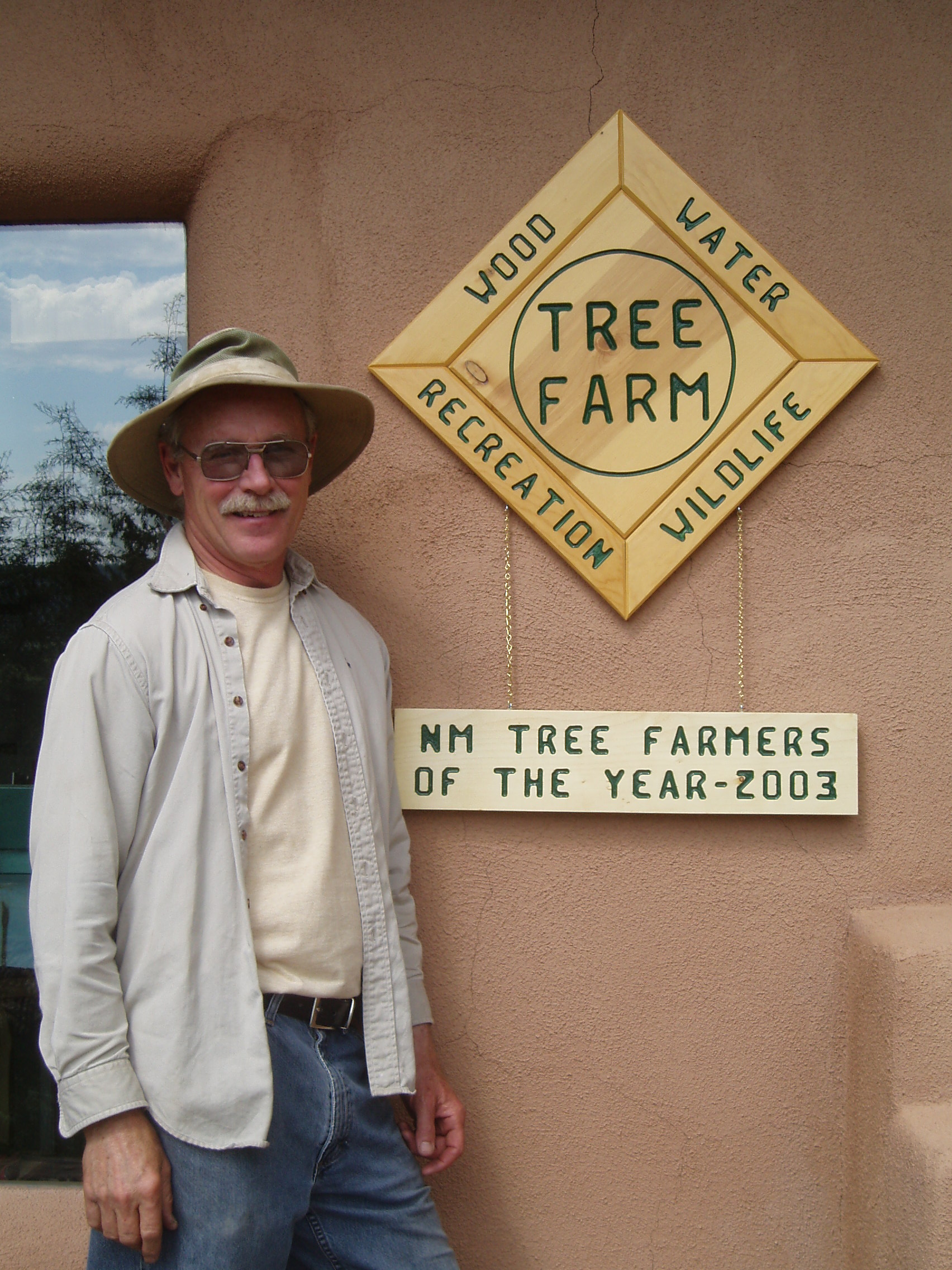Hart and Utilia Allex from New Mexico
 What Makes Them Outstanding?
What Makes Them Outstanding?
It has been said, one who doesn’t see the forest for the trees has his eyes closed. Hart and Utilia Allex eyes are wide open when it comes to the passion they possess for the conservation of their multiple Tree Farms in Northern New Mexico. Hart and Utilia have been New Mexico’s Outstanding Tree Farmer of the Year in 2003 and again in 2015. It’s time to share their obsession to restore their forest with the rest of the country. Hart and Utilia are Outstanding Tree Farmer of the Year due to their passion, not only for their own forests but for all forests, private and public. As a service forester to the Allex Tree Farm for the first time in March of 2003, I walked up to the edge of their forest and stood silently in amazement to the obvious hard work that they had put into transforming their Tree Farm into what it has become today, a production and resilient ecosystem admired by many but recreated by few. The Allex’s passion for their forest management skills would be very difficult to duplicate. In dealing with their forest resources, no task is too small to overlook or too large to confront head on. Hart has raw mental and physical energy that cannot be tamed. I have often remarked to Hart, If I could bottle and sell your energy, I would be a rich man. Once Hart’s mind to made up he is unwavering to what he can and will accomplish, his passion to restore his forests is much too great to contain.
Tree Farmer Story
Hart has a bachelor degree in biology and a master in biochemistry. Aren’t they the same you ask? Not according to my definition. Tree Huggers cannot see the trees for the forest. They think in black and white. Don’t cut trees alive or dead. Thinning young trees, cutting mature trees or cutting burned trees it is all the same to them. Leave the forest to Nature. Unfortunately, it is way too late for that since Humans have wrecked the forests of the West. They can only be repaired by Humans.
Tree Lovers, on the other hand, revere the forest because of the individual trees. To protect the forest and bring it back from the edge it is necessary to help each tree. That requires fixing the environment that has been causing all the stress to each tree. Some of the concerns are serious overcrowding, insect infestation, erosion, loss of wildlife habitat, and invasion of nonnative species. Humans have set the stage for all of it.
Tree Huggers like to say that the forests are in their current state due to over logging. I believe, especially here in the Southwest, the forests were wrecked by over grazing. Generations of cattle and sheep took out all the edible vegetation and compacted the soil. The lack of shade along with our arid climate cut the microclimate needed for plant germination. The lack of grass cut the normal cycle of ground fires. Our social response to wild fires (put them out) aided in the destruction.
and sheep took out all the edible vegetation and compacted the soil. The lack of shade along with our arid climate cut the microclimate needed for plant germination. The lack of grass cut the normal cycle of ground fires. Our social response to wild fires (put them out) aided in the destruction.
Without regular fire to thin out germinating trees the percentage trying to compete for our very limited resources went sky high. I have seen twenty ponderosa pine growing in four square feet. They are 30 years old with an inch and a half diameter and only green at the top.
Our national mental picture of forests arrives from the East and south where rainfall is not a problem. In those forests trees, can live and grow properly in very dense populations. Here it is impossible. But the image of a forest does not come from the Southwest. Getting people to understand proper spacing for our trees is probably impossible. A recent Tree Farmer magazine article showing a thinned forest in Arizona was termed a “clear-cut” by some Tree Hugger. What can you say?
So, my transition. When we bought our 70 acres in 1977 we split it with a friend. Part of the paper trail concerned usage of the land. One of the statements I put in said, “Neither of us could cut a tree without the permission of the other.” Now I can laugh at that statement and the mental attitude I had at the time. Now I cut thousands of trees a year and, sometimes, don’t feel like I am getting anywhere. We bought back his share a few years later.When we built our road, and started construction on our buildings I spent a lot of time trying to do it in a way to minimize the trees we had to cut. We even used the backhoe to dig some of them for transplanting. It was summer and they all died but you can see my method.
It wasn’t until a decade later that I had the time to pay attention to the forest and the trees. Our first effort was to thin ten acres under NM Forestry supervision. My spacing was much too close but I was concerned about beetle kill and snow load bending the living. I still had that clear cut mentality.More years passed-we were out of state.
Upon our return, in 1999, it was time to help our forest. We have thousands of the above-mentioned ponderosa per acre. I couldn’t walk through most of it. They obviously weren’t growing. But the ten acres thinned a decade earlier looked great. I had my marching orders. We hit the first ten acres again and then did another five. After doing a second five it seemed like cut and burn, cut and burn, cut and burn was all we were doing. My wife calls it my passion. We give away over 50 pickup loads of firewood a year.
But what a magnificent transformation. I love walking in my forest. My tree spacing has allowed for sunlight on the forest floor. The resulting vegetation is a sight for sore eyes in this area of pine needles instead of grass. My walks now include a spray paint can to mark the next bunch of trees to go. Done is not a word we can use but progress is significant and very rewarding.Hart and Utilia Allex - both retired educators have kept records of all the activities they have accomplished on their Family Forest from the very beginning. Their Forest Management Plan (first developed in September 2004) is a living document growing in content every year.Recently, the Allex’s have been fortunate in obtaining funds to purchase additional forested properties. As funds and property become available, they strive to add properties to their to-thin-list and work their forestry magic one property at a time.
So, their passion continues. Currently, the three ranches combined are 255 acres in size including 59 acres of irrigated pasture land and 196 woodland acreage certified as a Tree Farm. In addition, the word Foundation has been discussed and perhaps soon additional funds may be available for a wide range of forestry applications. The Allex’s have been in contact with New Mexico Highlands University, Department of Natural Resources in the effort to facilitate possible forestry field studies for future forestry students. Hart and Utilia proudly display’s their Family Forest signs on their properties front gates.
Wood
The Allex’s strive for a healthy forest which will foster a healthy population of wildlife. As they thin they are opening the closed canopy which in-turn will provide additional value in recreation and access. Precommercial thinning, products derived include: fuelwood, latillas, posts and the occasional sawlog. Several areas have been entered more than once.
Rancho de Jicarita Ranch: 45 forested acres, 25 non-forested acres. Thinned the forest around the house from 1988 until 2010 with many interruptions. Well over 1,000 truckloads of wood went out. Ojito de Caballo Ranch: 131 forested acres, 34 non-forested acres. Initial thinning was completed in 2013 with a second entry completed in 2014. The pasture was also reseeded that summer. Well over 400 truckloads already removed. Property still needs the second entry on top however the  canyon is completed.
canyon is completed.
Highland Ranch: 20 forested acres, 0 non-forested acres. All 20 acres have been thinned to date.
The Allexs main objective is often a heavy thinning of ponderosa pine with dwarf mistletoe. Trees which are too dense or are infested with insects and/or diseases are removed for sawlogs, latillas, posts and fuelwood. They use fire (burn slash piles) to reduce fuel loading. This reduction of fuels protects the forest from wildland fires, insects and diseases. The Allex’s charge for these woody products (which were given away at first) to generate the funds to keep a crew working in the woods most days. With efficient woods operations, they can generally keep the operation in the black while creating jobs in a poor community.
Water
Hart has made every attempt possible to control erosion and damaging water flow. The compuertas (head gates) in use on the acequias were a constant source of concern. Previously, the method for damming the water was to make a dam every couple weeks with sticks, rocks, logs, plastic and lots of shovels full of dirt. Each time water was released, it would widen the area through erosion. Hart purchased $500 worth of steel plate and used a welder and backhoe to install head gates on the acequias in 1990 stopping the soil loss. He used branches from the junipers to slow down the water flow on several old roads to stop serious erosion. The south road is almost non-existent now due to revegetation efforts. They have installed two ponds in the pastures and rebuilt an older one to include an island for wildlife habitat. Now and then they see ducks in these ponds. There are three parallel acequias going through the property all fed by the Santa Barbara River from the main head gate several miles away. On the extreme north end of the ranch the land drops down a northeast-facing slope into the Canada Honda. This piece has white fir mixed with ponderosa pine and Douglas-fir and includes a meadow at the bottom with a spring.
Eliminating cattle from the grazing of newly cut hay fields has helped our stream banks recover. The erosion caused by herds of hoofs on soft wet dirt was a disaster. At least the elk spend the bulk of their time eating in the fields after the water has been turned off. Eliminating cattle from the south slope has made a huge difference in revegetation efforts. The next step is to eliminate cattle from the forest through fencing.
Wildlife Including Threatened and Endangered Species
With tree thinning comes a flush of grasses, and with the grasses comes wildlife enthralled with the improved wildlife habitat. The Allexs are full of stories of how deer and elk spend the bulk of their time on their thinned properties. They also see signs of bear, fox, bobcats. Bird diversity increases each year as more acres are thinned. They do allow limited hunting; but many hikers come through the area to view wildlife.
Recreation and Aesthetics Including Special Sites
Hart and Utilia enjoy showing their property to friends, family, and especially elders in their community. Hart is inspired by the tears old-timers cry when they see the thinned forests which remind them of their forest memories from their youth. In an area where land ownership is a traditional value, families are willing to sell to Hart because they know their land will be better cared for. They also know that Hart will work with them to allow hunting, hiking, snow shoeing, cross country skiing, elk watching, bird watching, four wheeling and many other non-destructive activities on the land. Hart has a keen eye for unique places and is careful to develop special areas such as springs and drainages. Property that seemed dry when overpopulated with trees, become productive wet areas with diverse fauna and flora. The Allex’s are also artists who use the wood from their property to create beautiful furniture.


